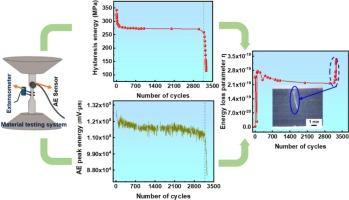基于声发射监测的低周金属疲劳试验早期疲劳损伤演化与裂纹识别
IF 6.8
2区 材料科学
Q1 ENGINEERING, MECHANICAL
引用次数: 0
摘要
采用声发射(AE)监测方法研究了Q235钢在单轴拉压载荷作用下的低周疲劳损伤行为。疲劳损伤演化与声发射特征参数之间存在较强的相关性。其中,声发射信号特征与加载方式有明显的相关性,拉伸卸载和压缩加载阶段是主要的声发射源,并且声发射能量在应变接近于零时达到峰值。峰值声发射能量、迟滞曲线面积和最大轴向拉应力在疲劳过程中呈现一致的趋势,有效地表征了疲劳阶段的损伤演变。此外,通过对试件进行相应疲劳循环的分析,探讨了微观组织的演变。基于上述结果,成功建立了基于声发射能量的识别模型,实现了对毫米级疲劳裂纹的精确检测。该模型为金属低周疲劳损伤声发射在线监测提供了可靠的理论基础。本文章由计算机程序翻译,如有差异,请以英文原文为准。

Early fatigue damage evolution and crack recognition in low-cycle metal fatigue testing based on acoustic emission monitoring
Acoustic emission (AE) monitoring is employed to investigate the low-cycle fatigue damage behavior of Q235 steel under uniaxial tensile-compressive loading in this study. A strong correlation is revealed between the fatigue damage evolution and acoustic emission characteristic parameters. Here, there is a significant dependence of AE signal characteristics on the loading mode: the tensile unloading and compressive loading stages are the main acoustic emission sources, and the AE energy peaks as strain approaches zero. The peak acoustic emission energy, hysteresis curve area, and maximum axial tensile stress exhibit consistent trends during fatigue, effectively characterizing damage evolution across fatigue stages. Furthermore, microstructural evolution is explored by analyzing specimens subjected to corresponding fatigue cycles. By means of the aforementioned results, an AE energy-based recognition model is successfully developed, enabling accurate detection of millimeter-scale fatigue cracks. This model provides a reliable theoretical foundation for the online AE monitoring of low-cycle fatigue damage in metals.
求助全文
通过发布文献求助,成功后即可免费获取论文全文。
去求助
来源期刊

International Journal of Fatigue
工程技术-材料科学:综合
CiteScore
10.70
自引率
21.70%
发文量
619
审稿时长
58 days
期刊介绍:
Typical subjects discussed in International Journal of Fatigue address:
Novel fatigue testing and characterization methods (new kinds of fatigue tests, critical evaluation of existing methods, in situ measurement of fatigue degradation, non-contact field measurements)
Multiaxial fatigue and complex loading effects of materials and structures, exploring state-of-the-art concepts in degradation under cyclic loading
Fatigue in the very high cycle regime, including failure mode transitions from surface to subsurface, effects of surface treatment, processing, and loading conditions
Modeling (including degradation processes and related driving forces, multiscale/multi-resolution methods, computational hierarchical and concurrent methods for coupled component and material responses, novel methods for notch root analysis, fracture mechanics, damage mechanics, crack growth kinetics, life prediction and durability, and prediction of stochastic fatigue behavior reflecting microstructure and service conditions)
Models for early stages of fatigue crack formation and growth that explicitly consider microstructure and relevant materials science aspects
Understanding the influence or manufacturing and processing route on fatigue degradation, and embedding this understanding in more predictive schemes for mitigation and design against fatigue
Prognosis and damage state awareness (including sensors, monitoring, methodology, interactive control, accelerated methods, data interpretation)
Applications of technologies associated with fatigue and their implications for structural integrity and reliability. This includes issues related to design, operation and maintenance, i.e., life cycle engineering
Smart materials and structures that can sense and mitigate fatigue degradation
Fatigue of devices and structures at small scales, including effects of process route and surfaces/interfaces.
 求助内容:
求助内容: 应助结果提醒方式:
应助结果提醒方式:


